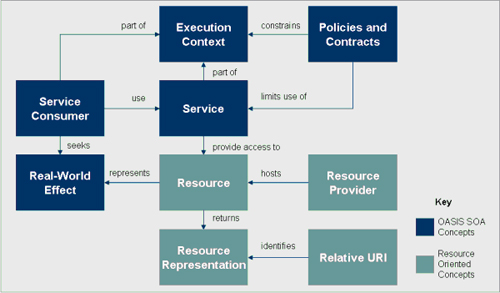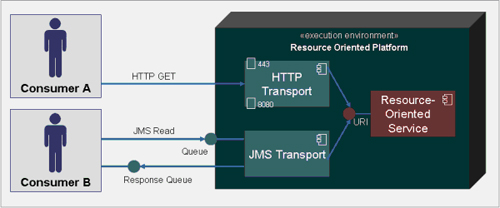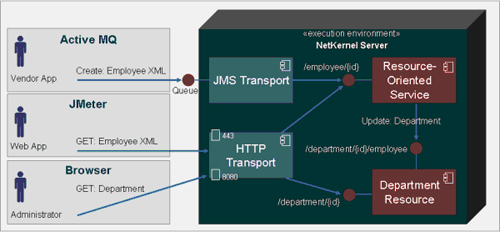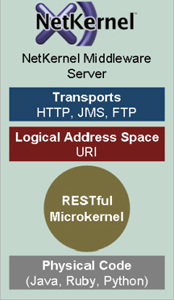According to a 2008 Gartner Survey1 there has been an increase in the number of organizations implementing web services using Representational State Transfer (REST) and Plain Old XML (POX). RESTful web services are less complex, require fewer skills and have a lower entry cost than WS-* SOAP web services. However, RESTful web services by themselves do not provide a complete enterprise solution.
Resource Oriented Architecture (ROA) extends the REST architectural style and provides a deeper, more extensible and transport independent foundation. While RESTful web services require the use of HTTP, resource-oriented services support additional transports such as JMS or FTP. In this article, I will cover the key concepts of ROA referencing a set of resource-oriented services implemented using 1060 NetKernel2 and Apache ActiveMQ3. The demo, along with the source code and tests, can be downloaded from the Collaborative Consulting download page4.
Resources are the foundation of ROA; a resource is an abstraction of information. For instance, an employee is an abstract set of data points that can have different representational forms such as a XHTML, JSON or XML. Each immutable resource representation is identified by a relative Universal Resource Indicator (URI) and may contain links to other resources.
 Figure 1 ROA Conceptual Model
Figure 1 ROA Conceptual Model
A URI consists of an address scheme, authority information and a path:
| URI Syntax | <scheme>:<authority><path> |
| URI Example | http://host/context/employee/1234 |
But a relative URI simply refers to the path or address, ‘/employee/1234’. Consequently, the resource representation identifier is transport independent because it is divorced of a scheme (recall: http:// from prior example) and can be reused in multiple environments (e.g. QA or PROD) because it does not contain authority information. Finally, a resource provider is used to host a resource (System of Record) and a service exposes a uniform set of actions, Create, Retrieve, Update, and Delete (C.R.U.D.), for stateless access to a resource.
Since resource-oriented services are transport-independent there must a mechanism for exposing them to the outside world. This is accomplished using transports that reside at the edge of a system, detect external events and map those events into internal resource requests. For example, an HTTP transport listens for a consumer’s request for a Uniform Resource Locator (URL), specifying an access method (e.g. GET, PUT, POST, & DELETE). The URL is transformed into an internal relative URI and the access method is translated into an action.
 Figure 2 Resource-Oriented Service Example
Figure 2 Resource-Oriented Service Example
A JMS transport uses the properties of the message to map the request to a resource-oriented service. The two required properties are the relative URI and action; and if the consumer requires a response, as is the case when the action is retrieve, then the ReplyTo property is populated. In addition, the message type is used to determine if the submitted resource representation is binary or text.
Resource-oriented services use the transport to provide a guarantee of consumer identity or authentication. In the case of HTTP, Basic or Digest Authentication5 is used while encrypted credentials are passed as a property if the transport is JMS. Consumer and provider can insure confidentiality by securing the transport (e.g. SSL or VPN) or securing the message using encryption.
To prevent unauthorized resource access consumers are granted privileges or roles (sets of privileges) where a privilege is comprised of a relative URI and an action. Additionally, regular expressions can be used to represent the URI decreasing the number of privileges that are required for authorization.
And actions that change the state of a resource including, create, update, and delete, are audited.
ROA can be implemented using several technology platforms including the Spring Framework6, Ruby on Rails7 and NetKernel. However, only NetKernel is built upon a Resource-Oriented Computing Platform8 (hence, “ROC”). The core of resource-oriented computing is the separation of logical requests for information (resources) from the physical mechanism (code), which delivers the requests. Services built using ROC have proven to be small, simple, flexible and require less code compared to other technology platforms.
NetKernel provides access to resources identified by a Universal Resource Identifier (URI) address. All URI addresses are managed within a logical address space. A REST-based micro-kernel handles all requests for resources, resolving the URI from the address space and returning a representation of that resource. Requests to the micro-kernel can also be made to create new resources or update or delete existing resources.
The demo consists of a set of resource-oriented services used to manage personnel. The employee resource-oriented service allows a consumer to create, retrieve, update and delete resources either via HTTP or JMS. For instance, a consumer can create an employee by issuing an HTTP PUT of an employee representation or by sending an employee representation to an ActiveMQ queue. Both approaches result in an internal sub-request to update a department resource.
 Figure 3 Resource-Oriented Service Demo
Figure 3 Resource-Oriented Service Demo
When a consumer requests a department resource, the returned representation contains links to the employee resources. The consumer can then extract the relative URI, /foo/business/employee/1234, to update that employee resource via JMS and, in turn, that action would result in a sub-request to update the department resource.
| <?xml version=”1.0″ encoding=”UTF-8″?> <department> <id>management</id> <staff> <employee>http://localhost:8060/foo/business/employee/1234</employee> <employee>http://localhost:8060/foo/business/employee/4321</employee> </staff> </department> |
Figure 4 Department Resource Representation
Implementing ROA provides an organization with enterprise architectural agility because it results in a logical layer of interconnected resources. This logical layer is decoupled from the physical implementation allowing consumer and provider to evolve independently over time. In addition, ROA pushes integration functionality to the edge of the network (as a URI), translating into better service management and scalability.

















